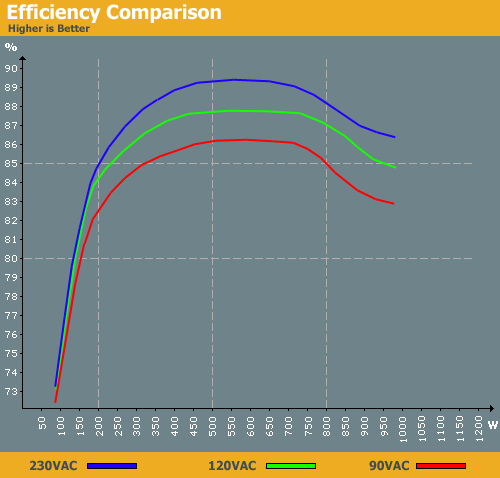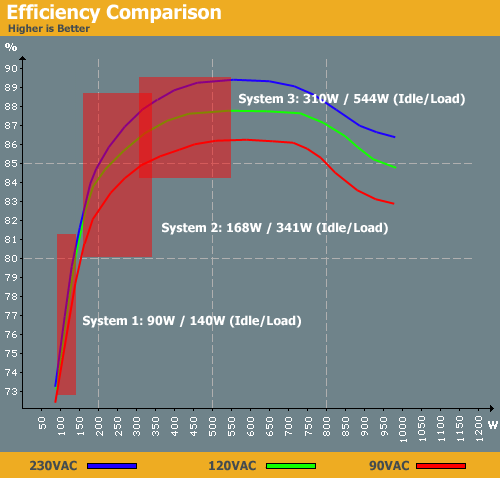Debunking Power Supply Myths
by Christoph Katzer on September 22, 2008 3:00 AM EST- Posted in
- Cases/Cooling/PSUs
Efficiency Explained
All power supplies have a specific efficiency curve, which we show in our reviews. As an example, we will use the Cooler Master UCP 900W power supply. Here is the efficiency curve we measured during testing:

Efficiency is the output power divided by the input power, as there is a certain amount of power lost during the AC to DC conversion. The x-axis shows the power supply load in Watts and the y-axis shows efficiency. Let's include our three sample systems in the chart see what sort of efficiency they would get with this power supply.

The first system causes this high-performance power supply to only run at 73% to 81% efficiency, depending on input voltage. Obviously, there's absolutely no need for a 900W power supply if you're running this type of computer.
The midrange system looks quite a bit better, allowing the PSU to run at 80% to 88% efficiency, although the latter only occurs at maximum load. Considering the vast majority of systems rarely run at 100% load most of the time, real-world efficiency will average closer to 82%. Office work and Internet surfing in particular will be at that level.
For the third system, a 900W power supply actually might start to make sense. It's still more than you need, but having a bit of extra room to grow isn't a bad idea. This system idles at over 300W, so it achieves a minimum 86% efficiency with 120VAC. When running a game or other demanding task, the PSU is finally able to reach its potential and provide 89% efficiency with 230VAC (or 87.5% with 120VAC).
The quick summary then is that if you don't have a system that uses 350W of power when idle, it's probably not worthwhile to purchase this type of power supply. Our high-end sample system more or less meets this qualification, and if you were to take such a system and overclock it, these high-end power supplies are actually required. The 8800 Ultra is one of the most demanding graphics cards currently available; however, the GTX 280 appears to require even more power, making that another candidate for this sort of PSU. (Unfortunately, our power supply testing labs didn't have the latest GPUs available for testing.)










98 Comments
View All Comments
LTG - Monday, September 22, 2008 - link
You can't just look at the TDP's, that's the problem.When you overclock the power demands can increase in a very non-linear way.
So for example I can't plan for one of the most popular 280 cards like the EVGA FTW 280 GTX. It's 11% core over clocked, what does that mean at the outlet? No good way to guess.
Same for a 3.6Ghz QC CPU - this is a very common overclock, yet there is no direct way to know it's power requirements.
I'm just saying this is not esoteric information, this would be data people really could use and can't get from the manufacturer.
xaris106 - Friday, November 7, 2008 - link
But you can. All you need is stock power consumption at load(Pstock), stock voltage(Vstock) and stock frequency(Fstock) The oc power is then:Poc = Pstock * (Foc/Fstock) * (Voc/Vstock)^2
nubie - Monday, September 22, 2008 - link
Unless they edited this, you are operating on a false assumption.(Unfortunately, our power supply testing labs didn't have the latest GPUs available for testing.)
A power supply testing lab doesn't need to have every component on hand because it uses a test bench to load the supplies.
Great article, way to dispel myths, I guess since I only plan to overclock with a single video card and one or two hard drives my PCPower Silencer 470 will be enough power for many years to come (which is what I hoped when I bought it, the only downside is the single 6-pin for the video card, when it can clearly handle much more.)
JarredWalton - Monday, September 22, 2008 - link
Just for the curious, AnandTech staff is scattered far and wide around the globe (well, at least the US and Europe). I'm west coast, Wes is east coast, Anand and Derek are in NC, Gary is in TX, and we have Johan and Liz in Belgium with Christoph in France. (That's not everyone, but you get the point.) Since we tend to focus on our own areas of testing, Derek and Anand have the most CPU/GPU hardware, I have laptops and displays, Gary has motherboards, etc. I can definitely say that Christoph isn't the only one without 48x0 and GTX 2x0 hardware. [Pardon me while I go cry in a corner now....]hyvonen - Wednesday, June 3, 2009 - link
Oh, so in order to get this power draw info on more components, I should beg Anand? :)LTG - Monday, September 22, 2008 - link
Totally understood, many companies now days are distributed and can't have every physical resource available to every person.However I would volunteer to send Christof a new 280 GTX to test if he decides it's worth it.
Serious - Just please send it back whenever finished :). And I waive all claims if it is accidentally fried by that fancy Chroma thingy.
ineedaname - Tuesday, November 2, 2010 - link
This article is well written and tried to put real life numbers and situations to the test on PSUs.However i felt that they should mention one other thing for people who are novice to computers. They should mention that just because a PSU is rated for 500w it doesn't necessarily mean that it will do the job even if your computer will only suck about 150w max. Because a 500w psu that comes along with a $50 case just won't do the job. Not because of the wattage rating but because they use crappy parts and workmanship; it'll just die in 3 months when the warranty is over.
gsuburban - Saturday, November 11, 2017 - link
This article was written in 2008. It would be great if it were updated with the more modern CPU's and Motherboards/Chipsets. Many experts suggest most systems don't need more than 400 watts as long as the PSU is a quality make.This would be a great addition with more modern hardware especially now that we have SSD's and M.2 hard drives.